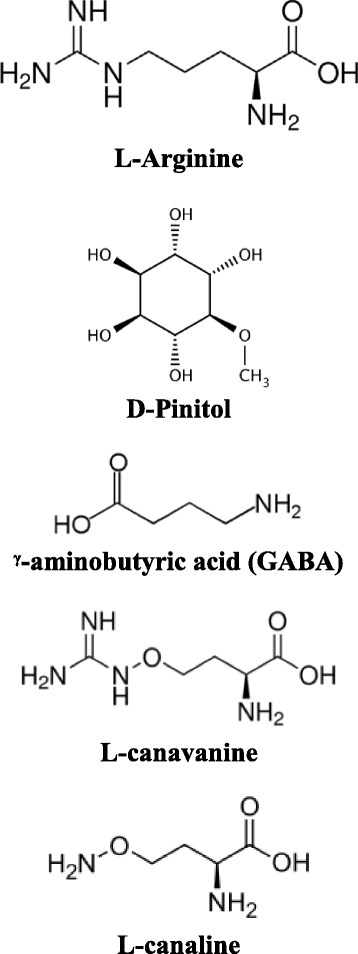The mutagenic and antimutagenic activity of Sutherlandia frutescens extracts and marker compounds
- PMID: 29544492
- PMCID: PMC5856389
- DOI: 10.1186/s12906-018-2159-z
The mutagenic and antimutagenic activity of Sutherlandia frutescens extracts and marker compounds
Abstract
Background: Sutherlandia frutescens (L.) R. Br is endemic to Southern Africa where it has been traditionally used for cancer and diabetes. In recent times it has been marketed for its reputed (but not proven) anticancer, antidiabetic and anti-HIV properties. Little is known about the mutagenic and antimutagenic potential of extracts and common marker compounds of Sutherlandia frutescens. Therefore this study aimed to investigate the putative efficacy and possible long-term adverse effects of using this herb.
Methods: Ethylacetate (EA) and 50% Methanol (MeOH) extracts were screened for mutagenic and antimutagenic activity using the Ames assay utilising TA97a, TA98, TA100 and TA102 in the presence and absence of metabolic activation. Four compounds, L-arginine, L-canavanine, GABA and D-pinitol known to occur in sutherlandia were also included. The total polyphenolic content of the both extracts was determined using the Folin-Ciocalteau method and FRAP and ABTS were used to determine the anti-oxidant potential of the extracts.
Results: The extracts and the standards did not show any cytotoxicity except in TA97a. The EA extract exhibited antimutagenicity against all the bacterial strains at all concentrations tested. The MeOH extract showed both pro-mutagenic and antimutagenic activities with 2-acetamidofluorene and aflatoxin B1 in the presence of metabolic activation of TA98 and TA100, respectively. All compounds, except L-canavanine exhibited antimutagenic activity against all strains. L-canavanine, on the other hand showed co-mutagenicity with 9-aminoacridine on TA97a, at all test concentrations. The extracts and pure compounds exhibited their antimutagenic activity in a dose response manner. L-arginine and GABA showed an some antimutagenic response. EA extract had three times the total phenolic content (12.56 μg GE / mg) observed in the MeOH extract. There was correlation between total phenolic content, antioxidant potential and antimutagenicity.
Conclusion: Both extracts exhibited a protective effect, with the EA extract exhibiting greater potency. L-canavanine acted as a co-mutagen in a dose response manner without metabolic activation. It is suggested that the EA extract be priotized for future development work as it showed a better risk profile and activity.
Keywords: Antimutagenic activity; Antioxidant activity; Fabaceae; Mutagenic activity; Promutagenicity; Sutherlandia frutescens; Total polyphenols.
Conflict of interest statement
Ethics approval and consent to participate
Not applicable as no animals or human beings were used.
Consent for publication
All the authors have given consent for this publication.
Competing interests
The authors declare that they have no competing interests.
Publisher’s Note
Springer Nature remains neutral with regard to jurisdictional claims in published maps and institutional affiliations.
Figures
Similar articles
-
The correlation between antimutagenic activity and total phenolic content of extracts of 31 plant species with high antioxidant activity.BMC Complement Altern Med. 2016 Nov 29;16(1):490. doi: 10.1186/s12906-016-1437-x. BMC Complement Altern Med. 2016. PMID: 27899116 Free PMC article.
-
Evaluation of the mutagenic and antimutagenic effects of South African plants.J Ethnopharmacol. 2006 Jun 15;106(1):44-50. doi: 10.1016/j.jep.2005.11.030. Epub 2006 Jan 18. J Ethnopharmacol. 2006. PMID: 16417980
-
Isolation and characterization of the compounds responsible for the antimutagenic activity of Combretum microphyllum (Combretaceae) leaf extracts.BMC Complement Altern Med. 2017 Sep 6;17(1):446. doi: 10.1186/s12906-017-1935-5. BMC Complement Altern Med. 2017. PMID: 28874162 Free PMC article.
-
Antimutagenicity profiles of some natural substances.Mutat Res. 1992 Jun;267(2):157-72. doi: 10.1016/0027-5107(92)90060-f. Mutat Res. 1992. PMID: 1376418 Review.
-
Mutagenic potential of medicinal plants evaluated by the Ames Salmonella/microsome assay: A systematic review.Mutat Res Rev Mutat Res. 2020 Oct-Dec;786:108338. doi: 10.1016/j.mrrev.2020.108338. Epub 2020 Oct 18. Mutat Res Rev Mutat Res. 2020. PMID: 33339578
Cited by
-
Giardia duodenalis Virulence - "To Be, or Not To Be".Curr Trop Med Rep. 2021;8(4):246-256. doi: 10.1007/s40475-021-00248-z. Epub 2021 Oct 21. Curr Trop Med Rep. 2021. PMID: 34697581 Free PMC article. Review.
-
Phytochemistry, Ethnopharmacology, and Pharmacology of Lessertia frutescens (Cancer Bush): A Comprehensive Review.Plants (Basel). 2025 Jul 8;14(14):2086. doi: 10.3390/plants14142086. Plants (Basel). 2025. PMID: 40733322 Free PMC article. Review.
-
The Implication of Chemotypic Variation on the Anti-Oxidant and Anti-Cancer Activities of Sutherlandia frutescens (L.) R.Br. (Fabaceae) from Different Geographic Locations.Antioxidants (Basel). 2020 Feb 13;9(2):152. doi: 10.3390/antiox9020152. Antioxidants (Basel). 2020. PMID: 32069826 Free PMC article.
References
-
- Mander M, Mander J, Breen C, et al. Promoting the cultivation of indigenous plants for markets: experiences from KwaZulu-Natal, South Africa. In: RRB L, Temu AB, Melnyk M, et al., editors. Domestication and commercialization of non-timber forest products in agroforestry systems: proceedings of an international conference held in Nairobi, Kenya 19-23 February 1996. 1996.
-
- Mander M. Marketing of Indigenous Medicinal Plants in South Africa. A case study in KwaZulu-Natal. Rome: Food and Agricultural Organization of the United Nations; 1998.
-
- van Wyk B-E. An ethnobotanical survey of medicinal plants in the southern Karoo, South Africa. S Afr J Bot. 2008;74:696–704. doi: 10.1016/j.sajb.2008.05.001. - DOI
-
- Naidoo V, Seier J. Preclinical safety testing of herbal remedies. In: Katerere DR, Luseba D, editors. Ethnoveterinary botanical medicines for animal health. Boca Raton: CRC Press (Taylor and Francis Group); 2010. pp. 69–93.
MeSH terms
Substances
LinkOut - more resources
Full Text Sources
Other Literature Sources
Miscellaneous


